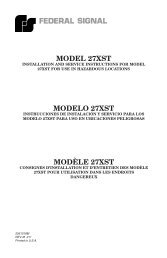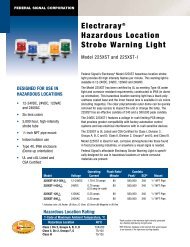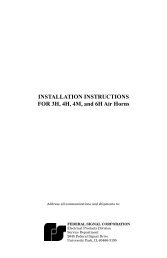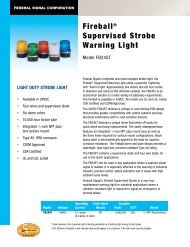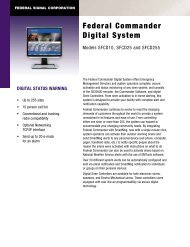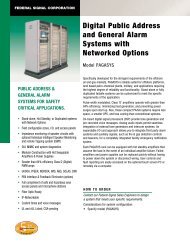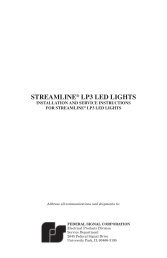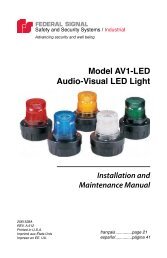UltraVoice Manual - Alerting & Notification
UltraVoice Manual - Alerting & Notification
UltraVoice Manual - Alerting & Notification
You also want an ePaper? Increase the reach of your titles
YUMPU automatically turns print PDFs into web optimized ePapers that Google loves.
and C71 to the VCO circuit. If the<br />
Steering line voltage is to low,<br />
connecting one or more of these<br />
caps into the circuit will increase<br />
the steering line voltage. Start<br />
with C68 and additional caps as<br />
needed to increase the voltage.<br />
For best receiver performance,<br />
this should be between 2 and 10<br />
VDC.<br />
F. Setting the Synthesizer on<br />
frequency<br />
1. Set the service monitor to receive<br />
VCO frequency. Monitor the<br />
frequency of the VCO by placing<br />
a pickup loop on top of the VCO<br />
IC. This is U7 for 2005026 and<br />
2005027 receivers or U9 for<br />
2005240 receivers. (pickup loop<br />
requires no electrical connection<br />
to VCO, just close proximity).<br />
2. The VCO frequency should be<br />
the receive frequency -21.4 MHz,<br />
unless the unit is a Lowband unit,<br />
in which case the frequency will<br />
be the receive frequency<br />
+21.4 MHz.<br />
3. Adjust the frequency of the VCO<br />
using the trimmer cap in TCXO<br />
U1 until the frequency is within<br />
+ /- 300Hz, + /- 150 Hz for<br />
narrowband receivers.<br />
G. Aligning the receiver and<br />
setting squelch<br />
1. Using a service monitor set in<br />
generate mode, inject an<br />
unmodulated RF carrier signal<br />
into the receiver at a 100 V<br />
Federal Signal <strong>UltraVoice</strong><br />
Installation and Operation <strong>Manual</strong><br />
MAINTENANCE<br />
62<br />
carrier level. Open the squelch<br />
pot R1 fully open.<br />
2. Using an analog DC voltmeter,<br />
monitor the DC voltage on TP1.<br />
3. Adjust the coils in FL1 and then<br />
FL3 (FL1 and FL2 for 2005240<br />
rev A – G receivers, do not adjust<br />
from 5240 G or greater) for the<br />
most voltage on TP1. TP1 may<br />
rise to about 2.0 Volts so it may<br />
be necessary to turn down the<br />
carrier level from the service<br />
monitor during the tuning<br />
process.<br />
4. Set the carrier to a 0.5 V level<br />
and re-tune the coils in FL1 and<br />
FL3 (FL1 and FL2 for 2005240<br />
receivers) after the first pass<br />
through, as tuning the stages<br />
ahead of a coil can change it‟s<br />
tuning.<br />
5. Modulate the signal into the<br />
receiver with a 1 kHz tone at<br />
3 kHz deviation (1.5 kHz for<br />
narrowband receivers).<br />
6. Monitor the receive audio, at the<br />
2005698 controller card Rx test<br />
TP16, with oscilloscope and<br />
adjust coil L1 for the most level.<br />
7. Connect the service monitor<br />
SINAD meter input to the TP16<br />
on the controller card and reduce<br />
the level of the RF signal from the<br />
service monitor until the SINAD<br />
meter reads 12 dB. The reading<br />
must be less than 0.35 V.



